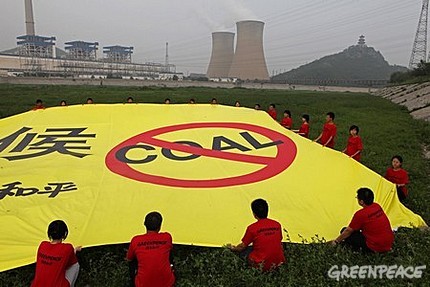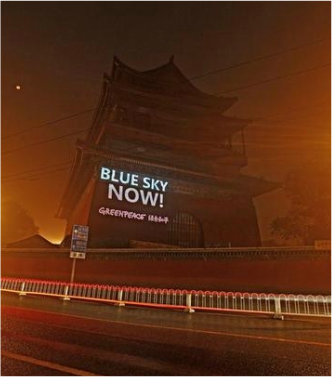GreenPeace East Asia
How effective has it been?
The actions of Greenpeace seem to be effective, using their profound recognition to raise the awareness of these issues. The investigation and research into these issues have effectively gauged the detrimental impacts of the air quality, thus advocating strategies that would be most effective based on their analysis. However, the scattered protests aren't clearly demonstrating to the general public that this is an impending issue. Of course, their website attempt to lobby for the immediate action against air pollution, but their limiting factor is that their only main medium is through sporadic protests or the internet, with action only viable when large masses demand change. Therefore, Greenpeace needs to be seemingly more proactive, with awareness being the primary goals towards the policy change that is required. In conjunction, whilst their investigations and reports provide great detail and information, there is limited visibility and ability to spread the awareness.
In addressing the criteria, Greenpeace has prominently made informing the masses as top priority. The spreading of this awareness has been very effective, although somewhat limited, but aids in the achievement of a general consensus to solve the impeding issue. The organisation has also set-up various monitoring programs, allowing the effective locating and prioritizing of problematic areas, whilst also conveying the necessary steps towards success. Even the Chinese coal mining industry is embracing these solutions, with the slowing coal consumption mid 2013 seeing some major companies taking part in unique actions. Most notably, Shenhua Energy has been involved in a joint investment project for the construction of wind farms with Hydra Tasmania [5]. Similarly, other leading coal industries are also moving towards renewable energy, with most capitalizing on the already prominent renewable energy industry and making the most of it. We can clearly see that these are off the back of a widespread awareness movement that has seen pressure applied for cleaner air quality, with organisations such as Greenpeace being detrimental to the cause. With few negatives, Greenpeace continues to play a pivotal role in the reduction of China's air pollution.
In addressing the criteria, Greenpeace has prominently made informing the masses as top priority. The spreading of this awareness has been very effective, although somewhat limited, but aids in the achievement of a general consensus to solve the impeding issue. The organisation has also set-up various monitoring programs, allowing the effective locating and prioritizing of problematic areas, whilst also conveying the necessary steps towards success. Even the Chinese coal mining industry is embracing these solutions, with the slowing coal consumption mid 2013 seeing some major companies taking part in unique actions. Most notably, Shenhua Energy has been involved in a joint investment project for the construction of wind farms with Hydra Tasmania [5]. Similarly, other leading coal industries are also moving towards renewable energy, with most capitalizing on the already prominent renewable energy industry and making the most of it. We can clearly see that these are off the back of a widespread awareness movement that has seen pressure applied for cleaner air quality, with organisations such as Greenpeace being detrimental to the cause. With few negatives, Greenpeace continues to play a pivotal role in the reduction of China's air pollution.
References:
[1] Greenpeace. (2014). What We Do About Air Pollution. Available: http://www.greenpeace.org/eastasia/campaigns/air-pollution/work/. Last accessed 15th Oct 2014.
[2]Greenpeace (2012) Dangerous Breathing, Beijing: Greenpeace.
[3] Zhang Kai. (2014). AIRPOCALYPSE HITS BEIJING- AND BREAKS DEVASTATING NEW RECORD. Available: http://greenpeaceblogs.org/2014/10/10/airpocalypse-hits-beijing-breaks-devastating-new-record/. Last accessed 20th Oct 2014.
[4] Greenpeace. (2013). THE TURNING POINT HAPPENS ON CHINESE TWITTER. Available: www.greenpeace.org/eastasia/specials/gpm04/twitter-weibo-different-data/. Last accessed 24th Oct 2014.
[5] Lifeng Wang. (2013). THE CHINESE COAL INDUSTRY RESPONDS TO WEAKENING DEMAND AND A FLOOD OF IMPORTED COAL. Available: http://greenpeaceblogs.org/2013/05/24/the-chinese-coal-industry-responds-to-weakening-demand-and-a-flood-of-imported-coal/. Last accessed 22nd Oct 2014.
[6] Greenpeace. (2009). Chinese Power Companies called out. Available: http://www.greenpeace.org/international/en/news/features/china-polluting-power280709/. Last accessed 24th Oct 2014.
[7]Jim Antal. (2014). Worldwide Breaking News. Available: http://www.rightnow.io/breaking-news/beijing_bn_1412066748109.html. Last accessed 24th Oct 2014.
[2]Greenpeace (2012) Dangerous Breathing, Beijing: Greenpeace.
[3] Zhang Kai. (2014). AIRPOCALYPSE HITS BEIJING- AND BREAKS DEVASTATING NEW RECORD. Available: http://greenpeaceblogs.org/2014/10/10/airpocalypse-hits-beijing-breaks-devastating-new-record/. Last accessed 20th Oct 2014.
[4] Greenpeace. (2013). THE TURNING POINT HAPPENS ON CHINESE TWITTER. Available: www.greenpeace.org/eastasia/specials/gpm04/twitter-weibo-different-data/. Last accessed 24th Oct 2014.
[5] Lifeng Wang. (2013). THE CHINESE COAL INDUSTRY RESPONDS TO WEAKENING DEMAND AND A FLOOD OF IMPORTED COAL. Available: http://greenpeaceblogs.org/2013/05/24/the-chinese-coal-industry-responds-to-weakening-demand-and-a-flood-of-imported-coal/. Last accessed 22nd Oct 2014.
[6] Greenpeace. (2009). Chinese Power Companies called out. Available: http://www.greenpeace.org/international/en/news/features/china-polluting-power280709/. Last accessed 24th Oct 2014.
[7]Jim Antal. (2014). Worldwide Breaking News. Available: http://www.rightnow.io/breaking-news/beijing_bn_1412066748109.html. Last accessed 24th Oct 2014.


